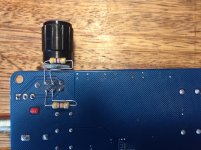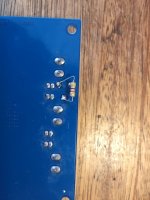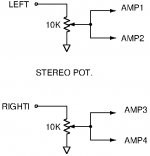I've connected resistors as discussed above - the amplifiers are now dead quiet with everything at max volume, and I have a far more useful volume range, so I'm well pleased. During this exercise, I also discovered the source of a high-pitched buzz that was evident at full volume - it turned out to be a poor connection on the DC barrel for the stereo amp.
Attachments
Hey there
I am trying to put together a cheap amplifier and I just need last parts, I should have already completed this project but life is hard and busy.
So, I have 4x tpa3116d2 (mono) driving 4x (unknown 8ohm, 30wrms) speakers.
There are 2x AC-DC 24v 4(6)A PSU powering a pair of amplifier each one.
Now, I would like to place a volume control between line in (3.5mm aux or ble) and amplifiers but I am not sure about the input impedence of these boards. I can easily use a linear potentiometer but a logarithmic one is probably better, am I right?
Given that a stereo pot has 2 sets of terminals but I have 4 amps/speakers, can I just split the cables or will this give me interferences?
On aliexpress you can find many pre-amp boards built around the NE5532 chip, should I just get one of these? Deh...
Thx
I am trying to put together a cheap amplifier and I just need last parts, I should have already completed this project but life is hard and busy.
So, I have 4x tpa3116d2 (mono) driving 4x (unknown 8ohm, 30wrms) speakers.
There are 2x AC-DC 24v 4(6)A PSU powering a pair of amplifier each one.
Now, I would like to place a volume control between line in (3.5mm aux or ble) and amplifiers but I am not sure about the input impedence of these boards. I can easily use a linear potentiometer but a logarithmic one is probably better, am I right?
Given that a stereo pot has 2 sets of terminals but I have 4 amps/speakers, can I just split the cables or will this give me interferences?
On aliexpress you can find many pre-amp boards built around the NE5532 chip, should I just get one of these? Deh...
Thx
@ Morninglight.
Am I right that all 4 boards handle the same input signal? Thus, 4 speakers with mono sound.
I would like to have two boards/speakers carrying the L signal and the other pair handling the R signal.
Ideally there would be a dual gang pot to keep both signals isolated.
Thx
I would like to have two boards/speakers carrying the L signal and the other pair handling the R signal.
Ideally there would be a dual gang pot to keep both signals isolated.
Thx
I suggest the following connections (appended) using one stereo potentiometer.
In theory, a logarithmic potentiometer is best as it gives the best impression of the volume being increased regularly.
But, linear potentiometers are easier to find.
Attachments
I suggest the following connections (appended) using one stereo potentiometer.
In theory, a logarithmic potentiometer is best as it gives the best impression of the volume being increased regularly.
But, linear potentiometers are easier to find.
thx for the img FauxFrench, that's the same wiring I had in mind.
I never paid attention to the (audio) difference between a linear pot and a log one but I recently red about it so I may order both and try it myself. What (log) pot value should I get ?
( I'll connect the wiper lead to a microcontroller to drive some leds to show the volume )
thx for the img FauxFrench, that's the same wiring I had in mind.
I never paid attention to the (audio) difference between a linear pot and a log one but I recently red about it so I may order both and try it myself. What (log) pot value should I get ?
( I'll connect the wiper lead to a microcontroller to drive some leds to show the volume )
10k like in the diagram. I’ve been meaning to order more ALPS pots myself.
10k like in the diagram. I’ve been meaning to order more ALPS pots myself.
thought that was for the linear pot. I never worked with log pot till now
thought that was for the linear pot. I never worked with log pot till now
You’ll find a lot of 50k pots, too - they should work, haven’t tried them yet.
I checked on my own TPA3116 mono-board. The small trim-potentiometer used as volume control on that board also increase the volume when you turn clock-wise. For that board and looking at the rear side, the 4K7 resistor has to connect the lower pad/pot.terminal (furthest away from the edge) to the pad/pot.terminal to the right (direction of the power supply terminals).
What has to be linked to by-pass the pot?
Can these be used with DC in and OUT?
FauxFrench, is that decoupling capacitor board one you would recommend? How would you modify it for single rail DC?
Carte filtrante de redresseur d'amplificateur de Lusya double Module d'alimentation Audio de cc avec le B8 001 fini de capacite-in Amplificateur from Electronique on Aliexpress.com | Alibaba Group
Can these be used with DC in and OUT?
Yes.
Modification. I will suggest you this mono module instead:
Numerique Puissance Audio Amplificateur Conseil TPA3116 100 w DC 12 v 24 v Mono Canal BTL Out dans Amplificateur de Electronique sur AliExpress.com | Alibaba Group
The reason is, as I just noticed, the board you suggest uses 33uH ("330") chokes in the output filter. 33uH chokes of that type can only handle some 2Arms before saturation and you cannot use the full capacity of the TPA3116 chip.
The board I suggest uses 10uH ("100") chokes that can handle around 3-3.5Arms before saturation. Then you have more output power.
So I have a one of these boards in a 19v 4 ohm halfinator. I wasn't getting the volume output I should have got so I have bought a pre-amp. Does the above post mean that even with a pre-amp I am wasting my time, I simply won't get the most out of this board in teerms of volume at that voltage? Thanks!
In short and according to my views, yes.
Maximum output power can only be obtained when the output can be driven all the way to saturation against the supply voltage. With insufficient current rating of the filter chokes, the chokes may saturate from the output current before voltage saturation is achieved. When the output chokes saturate, their inductance is seriously reduced and the class D chip looks pretty much directly into the output filter capacitance. In particular for the carrier signal (some 400KHz), this is a huge problem and the output current limiters start distorting the output signal.
The sound level with insufficient output filter chokes is not much lower than with correct filter chokes but you may get very unpleasant distortion and you do not get most out of the class D amplifier.
Maximum output power can only be obtained when the output can be driven all the way to saturation against the supply voltage. With insufficient current rating of the filter chokes, the chokes may saturate from the output current before voltage saturation is achieved. When the output chokes saturate, their inductance is seriously reduced and the class D chip looks pretty much directly into the output filter capacitance. In particular for the carrier signal (some 400KHz), this is a huge problem and the output current limiters start distorting the output signal.
The sound level with insufficient output filter chokes is not much lower than with correct filter chokes but you may get very unpleasant distortion and you do not get most out of the class D amplifier.
Last edited:
First question, what is the value of the chokes already in place?
If higher than 10uH, you can replace them with 10uH. The TI datasheet (page 23) shows 10uH/680nF for the output filter. Check the value of the output filter capacitors as well.
Using 10uH will work. I have boards with 10uH/680nF and they work well.
If higher than 10uH, you can replace them with 10uH. The TI datasheet (page 23) shows 10uH/680nF for the output filter. Check the value of the output filter capacitors as well.
Using 10uH will work. I have boards with 10uH/680nF and they work well.
I haven't opened mine now, so I don't remember what types these inductors were, if shielded or not, least of all their value.
Maybe someone here knows what inductors values Breeze Audio used on their TPA3116.
What I did do was put heat paste on the heatsink's, and temp went way down. That is something everyone having a TPA3116 should check, whatever the amp brand.
Maybe someone here knows what inductors values Breeze Audio used on their TPA3116.
What I did do was put heat paste on the heatsink's, and temp went way down. That is something everyone having a TPA3116 should check, whatever the amp brand.
In short and according to my views, yes.
Maximum output power can only be obtained when the output can be driven all the way to saturation against the supply voltage. With insufficient current rating of the filter chokes, the chokes may saturate from the output current before voltage saturation is achieved. When the output chokes saturate, their inductance is seriously reduced and the class D chip looks pretty much directly into the output filter capacitance. In particular for the carrier signal (some 400KHz), this is a huge problem and the output current limiters start distorting the output signal.
The sound level with insufficient output filter chokes is not much lower than with correct filter chokes but you may get very unpleasant distortion and you do not get most out of the class D amplifier.
So I could replace the output caps with 10uH? Would this also potentially negate the need for a preamp to increase gain at higher voltages?
So I could replace the output caps with 10uH? Would this also potentially negate the need for a preamp to increase gain at higher voltages?
Change to 10uH chokes would have very little effect on the need for a pre-amp.
The pre-amp is used because the sound-level remains low when you turn the volume potentiometer fully up. You simply need more gain in the signal chain which the pre-amp delivers.
The 10uH chokes may allow you to turn the volume up a bit higher than before (before you hear distortion from saturation) IF the initial filter chokes have saturation problems.
- Home
- Amplifiers
- Class D
- TPA3116 D2 mono amplifier as a stereo system?


